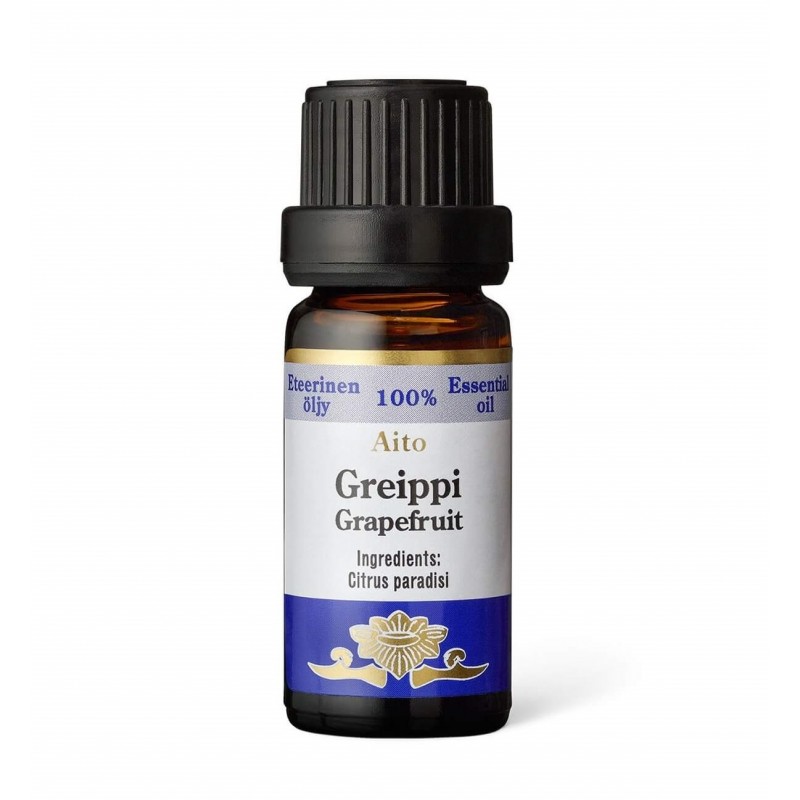



The main constituents are limonene, paradisiol, neral, geraniol, citronellal and citral. It's actions include; antibacterial, antidepressant, antiseptic (especially airborne), antitoxic, aperitif, astringent, depurative, digestive, disinfectant, diuretic, resolvent, stimulant, and general nerve tonic.
The oldest known mention of grapefruit comes from the 17th century, when this evergreen fruit tree was discovered on the island of Jamaica - hence the Latin name "paradisi". The English term, "grapefruit" stems from a most inaccurate description. A botanist named John Lunan, writing about the horticulture of the island, claimed the large round yellow fruit tasted like grapes. The name stuck, regardless of Lunan’s faulty characterization, however early varieties of grapefruit did look much like huge clusters of grapes, as the fruit hung in a bunch on a single branch.
An offspring of citrus, originally from Malaysia and south east Asia (where it still grows wild), known as the pummelo or shaddock. The sweet-sour fruit was not an immediate hit. In 1823 the first grapefruit were taken to Florida for cultivation. The common grapefruit of Florida groves is considered Citrus grandis and the first commercial grove was established about 1890. After World War II, the fruit became increasingly popular. Today it’s the second most important citrus worldwide and a key commercial crop in the U.S. states of Texas, Arizona, California and Florida. In Florida alone, more than 2.5 million tonnes of grapefruit are harvested annually. The U.S. now produces 60% of the world's grapefruit crop. Grapefruit are also grown commercially in Spain, Morocco, Israel, Jordan, South Africa, Brazil, Mexico, Jamaica, and Asia.
The grapefruit tree grows to be as large and vigorous as an orange tree; a mature tree may be from 4.5 to 8m high. This tree is the least hardy of all the citrus and requires the highest, most prolonged heat for good growth. A large, mature tree produces 500 to 700 fruit per year and one grapefruit can weigh up to 1/2kg.
Lemon-yellow when ripe, the fruit ranges from 100 to 150mm in diameter and averages twice as large as a medium-sized orange, with size depending upon the variety and growing conditions.
Its pulp is usually light yellowish, tender, and very full of juice, with a distinctive, mildly acid flavour. Several varieties have pink or red pulp. As a source of vitamin C, the grapefruit is exceeded among common fruits only by the orange and lemon. Grapefruit is eaten for breakfast, made into juice and added to salads. It is used as a flavouring in frozen desserts, baked goods, carbonated soft drinks & alcoholic drinks. Grapefruit can also be found in cosmetics, detergents, soaps and perfumes.
Grapefruit oil is cold pressed from the peel and is produced mainly in California. It has a refreshing, fresh, sweet, citrus scent and is pale-yellow to yellow. Like many citrus rind essential oils, it has unique fat-dissolving characteristics. It is a top note and blends well with bergamot and other citrus oils, black pepper, cardamom, coriander, cypress, geranium, juniper, lavender, neroli, palmarosa, petigrain, pine, and rosemary.
The main constituents are limonene, paradisiol, neral, geraniol, citronellal and citral. It's actions include; antibacterial, antidepressant, antiseptic (especially airborne), antitoxic, aperitif, astringent, depurative, digestive, disinfectant, diuretic, resolvent, stimulant, and general nerve tonic.
Grapefruit enhances the digestive, circulatory, glandular, urinary, and nervous systems. A stimulating lymphatic massage of grapefruit can promote the appearance of smooth, undimpled skin, enhance circulation, and help regulate healthy body fluid levels. Grapefruit promotes healthy skin and hair, creating an image of perfect health and radiance. It relieves congested and oily skin, having a toning effect on both skin and tissues. For this reason it is a good oil to use when treating cellulitis.
It assists the removal of toxic wastes from the body's cells and help regulate the balance of water in the tissues. Also reported to stimulate bile and the digestion of fats would lend it to help with weight loss. It is also used for it's cleansing effect on the blood, kidneys, liver and vascular system and is said to help dissolve gall stones. The aromatic influence of grapefruit helps decrease appetite and balance emotional extremes.
Grapefruit is most valuable when stress is present, as it has an overall uplifting effect. It's fresh aroma can help with nervous exhaustion, fatigue and lethargy. It can balance the central nervous system and therefore may help stabilize manic depression. Grapefruit oil has helped relieve migraine headaches, jet lag, alcohol and drug withdrawal, and helps reduce some premenstrual tension. Historical accounts show that this essential oil has great effects on depression and is very refreshing for the spirit. It is said to be euphoric and slightly hypnotic.